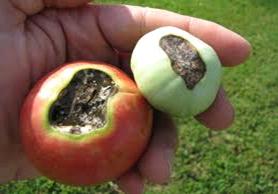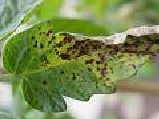Blossom-end rot is a disorder of tomato, squash, pepper, and all other fruiting vegetables. You notice that a dry sunken decay has developed on the blossom end (opposite the stem) of many fruit, especially the first fruit of the season. This is not a pest, parasite or disease process but is a physiological problem caused by a low level of calcium in the fruit itself.
Calcium is required in relatively large concentrations for normal cell growth. When a rapidly growing fruit is deprived of calcium, the tissues break down, leaving the characteristic lesion at the blossom end. Blossom-end rot develops when the fruit’s demand for calcium exceeds the supply in the soil. This may result from low calcium levels in the soil, drought stress, excessive soil moisture, and/or fluctuations due to rain or over watering. These conditions reduce the uptake and movement of calcium into the plant, or rapid, vegetative growth due to excessive nitrogen fertilization.
Early Blight:
 Symptoms which are first seen on leaves are dark brown, circular to oval spots, marked by concentric rings in a target pattern. These spots first appear on lower, shaded foliage, with spots growing together to blight a large portions or all of leaves. Cankers may form on older stems and blossom-drop may occur with loss of fruit. Blighted leaves are dark brown and die with foliage dying from the bottom of the plants upward. The fungus over-winters in infected plant debris and can survive in the soil . It also over-winters on seed and on weeds. Therefore, garden sanitation is important in early blight prevention. The fungus enters tomato plants through wounds and thrives during warm (optimum temperature of 85 F ) and moist conditions, including frequent rains, plant watering and heavy dews. Once the fungal spores are formed on infected plants, the spores are spread by wind, splashing rain.
Symptoms which are first seen on leaves are dark brown, circular to oval spots, marked by concentric rings in a target pattern. These spots first appear on lower, shaded foliage, with spots growing together to blight a large portions or all of leaves. Cankers may form on older stems and blossom-drop may occur with loss of fruit. Blighted leaves are dark brown and die with foliage dying from the bottom of the plants upward. The fungus over-winters in infected plant debris and can survive in the soil . It also over-winters on seed and on weeds. Therefore, garden sanitation is important in early blight prevention. The fungus enters tomato plants through wounds and thrives during warm (optimum temperature of 85 F ) and moist conditions, including frequent rains, plant watering and heavy dews. Once the fungal spores are formed on infected plants, the spores are spread by wind, splashing rain.
Leaf Spot
 Leaf spot is aptly named, because the primary symptom of the disease is that numerous brown spots appear on the leaves, approximately 1/16 to 1/8 inch in diameter. The spots lack a yellow halo, and, upon close inspection, have black specks in the center. there is no stem or fruit damage.
Leaf spot is aptly named, because the primary symptom of the disease is that numerous brown spots appear on the leaves, approximately 1/16 to 1/8 inch in diameter. The spots lack a yellow halo, and, upon close inspection, have black specks in the center. there is no stem or fruit damage.
Late Blight
 If your tomatoes have late blight, you will see spots that start out pale green, usually near the edges of tips of foliage, and turn brown to purplish-black. In humid conditions, a fuzzy mold appears on the undersides of leaves. The stems will develop black and brown spots that eventually spread. Entire vines can be killed very quickly in periods of high humidity. Fruit damage in the form of dark, leather patches that appear on the top and sides of the green fruit is another sign of late blight.
If your tomatoes have late blight, you will see spots that start out pale green, usually near the edges of tips of foliage, and turn brown to purplish-black. In humid conditions, a fuzzy mold appears on the undersides of leaves. The stems will develop black and brown spots that eventually spread. Entire vines can be killed very quickly in periods of high humidity. Fruit damage in the form of dark, leather patches that appear on the top and sides of the green fruit is another sign of late blight.

